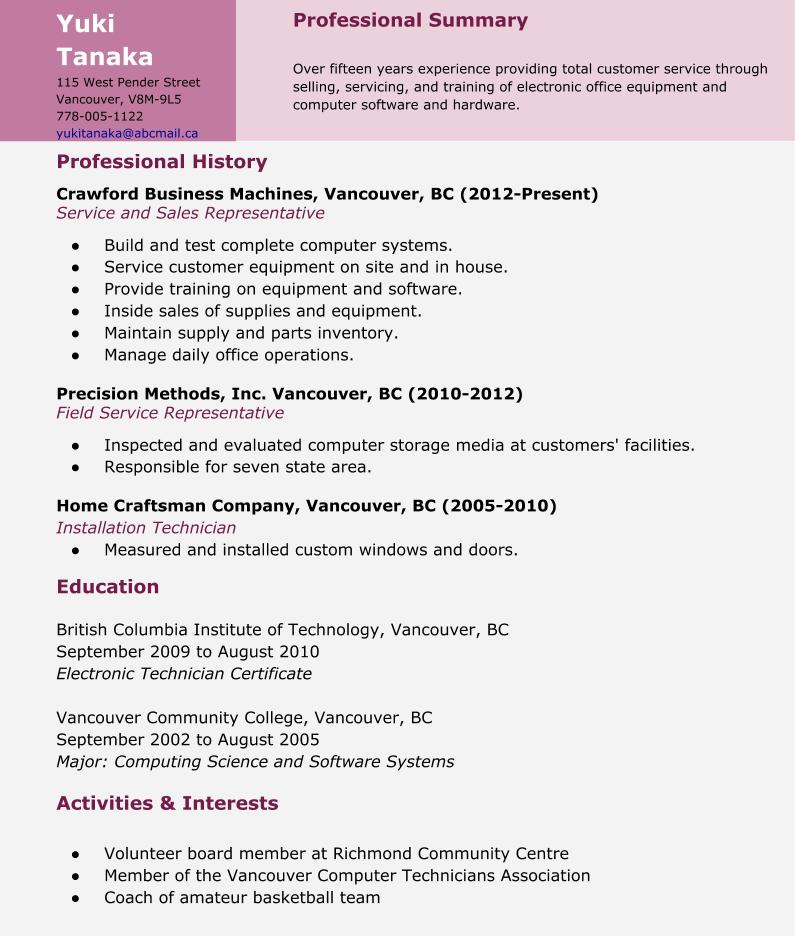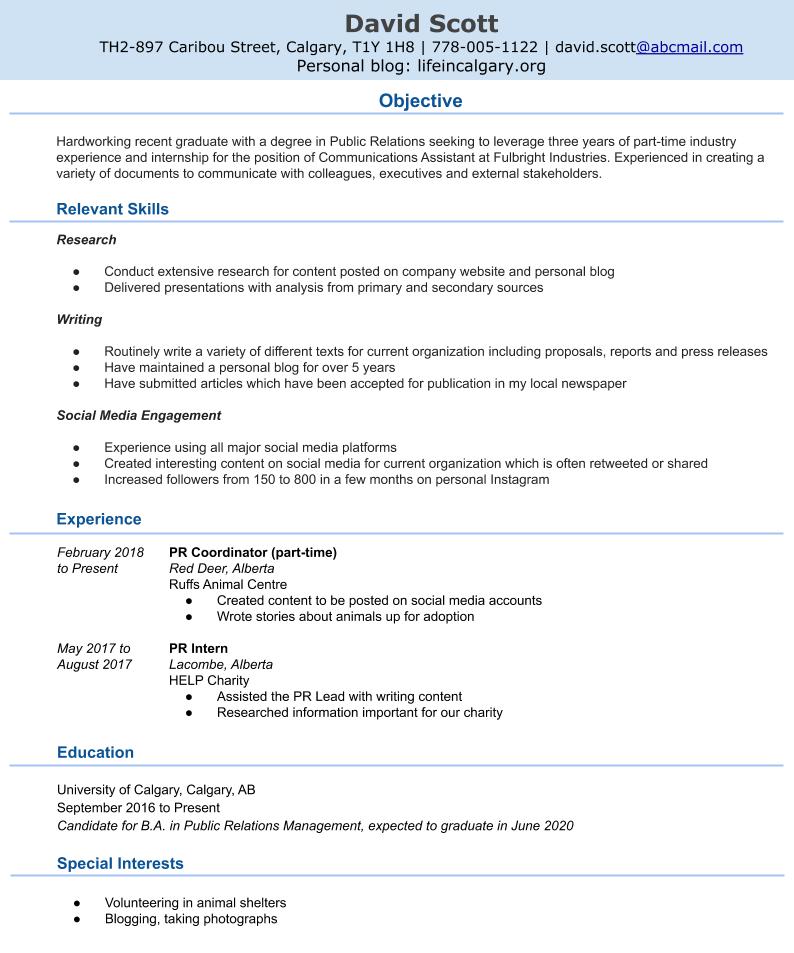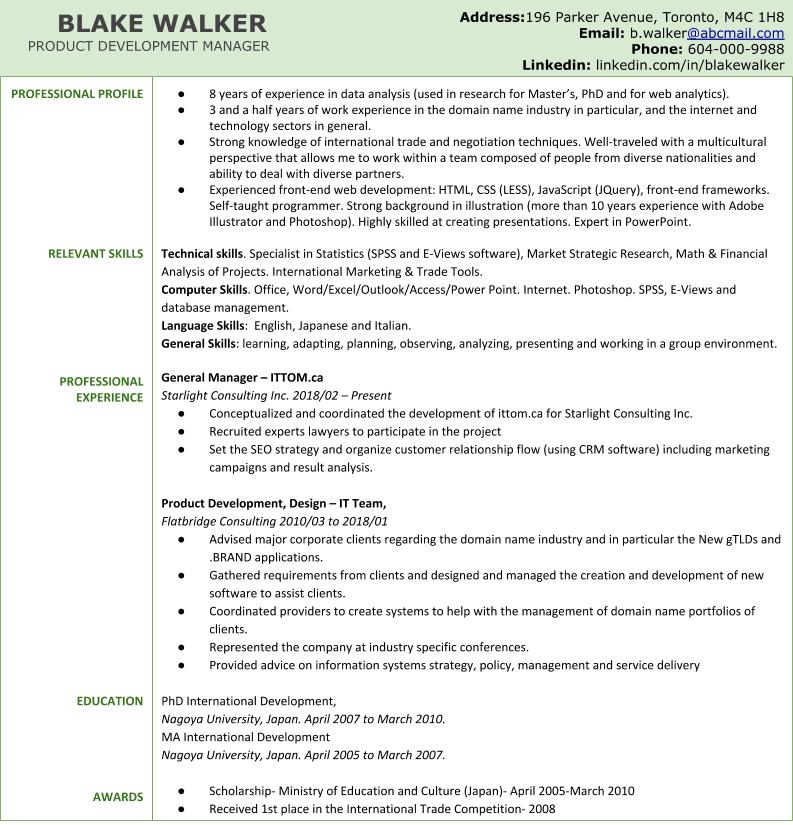19.3 Designing an Effective Résumé
A résumé is a document that summarizes your education, skills, talents, employment history, and experiences in a clear and concise format for potential employers. The résumé serves three distinct purposes that define its format, design, and presentation:
- To represent your relevant professional information in writing
- To demonstrate the relationship between your professional information and the problem or challenge the potential employer hopes to solve or address, often represented in the form of a job description or duties
- To get you an interview by clearly demonstrating you meet the minimum qualifications and have the professional background help the organization meet its goals
Before you start writing, it is important to first consider the rhetorical situation for this particular type of communication. What is the intended effect? What are you trying to accomplish? Who is your audience? How will they be accessing and reading your document? Each decision you make about what to include in your résumé and how it should look should be made with these factors in mind, plus more, based on your knowledge of the specific employer or position.
What to Include in Your Résumé
Résumés have several basic elements that employers look for, including your contact information, objective or goal, education and work experience. Each résumé format may organize the information in distinct ways based on the overall design strategy, but all information should be clear, concise, and accurate. The content in your résumé should be carefully selected to present the best, most applicable qualifications for a particular employer.
Contact Information
The contact information section is often located at the top of the document. The first element of the contact information is your name. You should use your full, legal name even if you go by your middle name or use a nickname. There will be plenty of time later to clarify what you prefer to be called, but all your application documents, including those that relate to payroll, your social insurance number, drug screenings, background checks, fingerprint records, transcripts, certificates or degrees, should feature your legal name. You should also include your address, phone number(s), and email address. If you maintain two addresses (e.g., a campus and a residential address), make it clear where you can be contacted by indicating the primary address. For business purposes, do not use an unprofessional email address like sexiluvr93@hotmale.com or tutifruti@yafoo.com. Create a new email account if needed with an address suitable for professional use.
Career Objective
The career objective part of your résumé is relatively simple to customize for an individual application. Your objective should reflect the audience’s need to quickly understand how you will help the organization achieve its goals.
Summary of Relevant Qualifications
The summary of relevant qualification gives you the chance to highlight your relevant experience and qualifications, and it gives the recruiter an overview of what will follow in your résumé. List four to eight bullet points with qualifications or experience specifically connected to the job requirements. Note that some applicants opt to include career objective or summary of relevant qualifications.
Education
You need to list your education in reverse chronological order, with your most recent degree first. List the school, dates of attendance, degree, and any certifications received. You may also want to highlight relevant coursework that directly relates to the position.
Work Experience
List in reverse chronological order your employment history, including the positions, companies, locations, dates, duties and skills demonstrated or acquired. You may choose to use active, descriptive sentences or bullet lists, but be consistent. Emphasize responsibilities that involved budgets, teamwork, supervision, and customer service when applying for positions in business and industry, but don’t let emphasis become exaggeration.
Skills
The skills section is optional but allows you to highlight a broad range of skills and qualifications, which can be useful. Include any applicable skills related to technology, communication and equipment. However, keep in mind that you do not want this list to be redundant. If you can better show these qualifications through descriptions of your experiences, that will have more impact.
Other relevant qualifications
If you have received awards or honours; given presentations; published papers or other materials; or have other qualifications of note and relevance to the position for which you’re applying, you can list these in an appropriately named section on your résumé.
Activities
An activities section is not required, however, listing your involvement in activities in the community and professional organizations can reflect well on your interest in the field, your motivation, and your time management skills.
References
You may choose to include references at the end of your résumé, though simply writing “references available upon request” is more common (and often more appropriate).
Résumé Formats
Résumés can be formatted in a number of ways, but the three most common are functional, chronological and combination. Table 19.1 describes each format.
| Type | Function | Advantage | Disadvantage |
| 1. Reverse Chronological | Reverse chronological résumés (also called reverse time order) focus on work history. | Demonstrates a consistent work history | It may be difficult to highlight skills and experience. |
| 2. Functional | Functional résumés (also called competency-based résumés) focus on skills. | Demonstrates skills that can clearly link to job functions or duties | It is often associated with people who have gaps in their employment history. |
| 3. Combination | Combination résumés list your skills and experience first, then employment history and education. | Highlights the skills you have that are relevant to the job and provides a reverse chronological work history | Some employers prefer a reverse chronological order. |
Table 19.1 | Common Résumé Formats
A chronological résumé, as illustrated in Figure 19.1, focuses on professional experience which is listed in reverse chronological order.

Whereas the chronological résumé focuses on employment history, a functional résumé, as shown in Figure 19.2, highlights relevant skills. A functional résumé is normally used when you do not have enough experience in the industry you are applying to or when you have many gaps in your employment history.

A combination résumé combines the reverse chronological and functional formats when both professional experience and skills are emphasized as demonstrated in Figure 19.3.

As you are planning what content to include in your résumé, know that information placed at the top of the document typically has the most impact. As you move down the page, though, lead with the most relevant, interesting sections, and organize the content to feature the experiences and skills that this employer will most value. You will have many questions about what you should and should not do as you are compiling and revising your résumé. You can try to find answers to these questions online, but once you know the basics, ultimately, you will need to make your own choices about the best way to present your qualifications.
If you are wondering whether or not to include a piece of information, focus on the audience’s needs. Will they find this information valuable in making a decision about you as a candidate? Does it reveal something important about your skills, interests, and qualifications? Does it reveal something new about you that is not already revealed in the document?
If you are wondering how to present a piece of information, know that the options are endless, but, again, you will want to focus on the audience. Is the content presented in a way that is easy to see and understand? Is it logically connected to the information around it?
Be confident as you make these decisions. There are fewer “rules” than you might think; the challenge is to create a document that is not just correct, but that strategically reveals you as a potential candidate for the job. You don’t want your résumé to look like a form or to be exactly like everyone else’s. Look for ways to include those things that express your personality and passion—the things that make you unique.
Additional Résumé Writing Strategies
Once you have chosen the appropriate format and have included the appropriate content, you need to review your résumé to ensure that the length is appropriate, action verbs describe your skills and experience and that the layout makes your résumé easy to read.
Length
You may be tempted to extend your résumé to more than one page, but don’t exceed that limit unless the additional page(s) will feature specific, relevant information that represents several years of work that directly relates to the position. The person reading your résumé will more than likely be sifting through many applicants and will not spend time reading several extra pages if the content is not directly relevant.
Use strong action verbs
Strong action verbs are words that you should use to describe your activities throughout the résumé, typically beginning each bullet point in the experience descriptions. These words should be varied (avoid repetition), vivid (be specific, descriptive), and honest (don’t overstate your activities or experience).
| Strong Action Verbs | achieved, analyzed, assessed, built, calculated, collaborated, completed, coordinated, created, defined, delivered, designed, developed, documented, evaluated, examined, improved, interpreted, managed, monitored, prepared, presented, programmed, provided, reduced, resolved, reported, researched, resolved, supervised, solved, succeeded, supported, surpassed |
Visual Design Considerations
The content and language in your résumé, as discussed in the previous section, is the first priority, as you figure out how to explain your experiences and show the employer that you meet the requirements for the position. The visual design of your résumé—the way the information is presented on the page—also deserves some careful planning and consideration because it has an impact on the way your audience will be able to read and understand the information.
Remember that your reader (e.g., an HR representative, a campus recruiter) might be reviewing many résumés in a row and perhaps reviewing them quickly. An effective visual design can help ensure that your résumé is accessible and that it makes a good impression, which will make them more likely to consider you a strong candidate!
Here are some simple things to keep in mind as you are finalizing the design of your résumé:
- Clear headings. Content needs to be categorized visually, with main section headings (e.g., Work Experience) and subheadings. Font size and type help visually organize the text on the page. All caps and bold are your best options for emphasizing headings and subheadings; italics and underlining are more difficult to read and should be used less often.
- White space. A résumé that is full of dense blocks of text becomes difficult to read. Our eyes need white space to help us understand how information is connected and how it relates to the content around it. Add space above headings and subheadings.
- Vertical alignment. To keep a document visually organized, similar headings and elements (e.g., a bulleted list) should fall along the same vertical line. This keeps the document clear and organized.
- Coherence and consistency. The same types of information (e.g., company name, dates) should be presented in the same way—same text formatting, positioning in the section. This helps “train” the reader’s eye, making sure they know where and how to find the information.
- Fonts and typography. To ensure that your résumé displays correctly and is compatible with Applicant Tracking Software (ATS), it’s best to use a common, standard, and professional font (Arial, Times New Roman, Tahoma). However, you can use more than one font—a serif font works well for headings alongside sans-serif fonts for body text.
Résumé Writing Tips
Here are four basic tips regarding how to approach writing your résumé:
- Create multiple versions. A résumé should be customized to the specific job you are applying for and adapted based on your knowledge of the employer. You should also consider how you will be submitting the document to determine the best formatting.
- Learn the conventions of your discipline. Not every professional context is the same. An engineer’s résumé will likely look very different from a financial advisor’s résumé simply based on the audience’s expectations.
- Eliminate errors from the document. Because the résumé is condensed and since it is used to evaluate you as a potential employee, there is little tolerance for typos or errors. Check grammar, spelling, design consistency, punctuation, and language. Then check it again and ask someone to review it.
- Update on a regular basis. Even if you expect to stay in a job in the long term, take notes and gather information for your résumé every couple of months or after you finish a major project. It’s difficult to remember the details of a complex project after the fact, so having that information documented is a huge asset.

